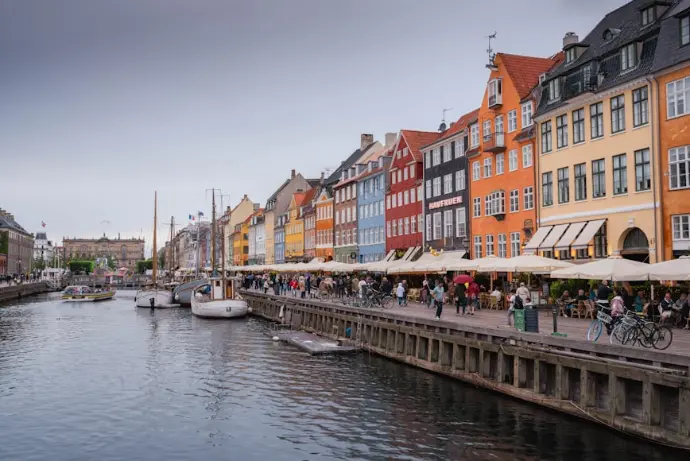Some landmarks aren’t just backdrops for photos; they linger in your senses, shaping how you remember a city long after you’ve gone. London and Copenhagen both offer such treasures — Tower Bridge and the Nyhavn waterfront — two very different icons that capture the spirit of their cities. One rises with Gothic grandeur over the Thames, the other glows with colour and warmth beside the harbour. Together, they tell stories of resilience, beauty, and the way cities breathe through their bridges and waterfronts.
Tower Bridge: London’s Living Landmark
Tower Bridge is impossible to ignore. Its twin towers stand proudly against the skyline, their stonework rich with detail, while modern glass buildings glitter in the distance. Step closer and the city shifts around you: the steady hum of traffic, the murmur of tourists, the click of cameras, the excited laughter of children running ahead. When the bascules begin to lift, the crowd falls quiet, a ripple of anticipation in the air. Then a ship slides through, and for a heartbeat, it feels like the bridge itself is taking a breath.
Inside, the exhibition draws you further in. Down in the Victorian engine rooms, the air still carries a tang of oil and iron, a reminder of the engineers who once kept the bridge alive with their daily labour. It’s a place where history clings to the walls, where effort and ingenuity are as much a part of the story as stone and steel.
London’s Skyline Through the Arches
From Tower Bridge, London unfolds in both directions. On one side, the Tower of London looms, a fortress of age-old stone. On the other, The Shard cuts into the sky, its glass shimmering like a blade of light. Beneath them both, the Thames flows steadily, carrying boats, reflections, and history in its current.
The bridge is more than a way across — it’s a symbol of how London connects itself, past to present, north to south. Just as Tower Bridge holds the city together, the London to Edinburgh route binds two of Britain’s great capitals. Journeys like these aren’t only practical links; they are threads of history, carrying with them people, trade, and culture, reminding us that travel is part of a nation’s living heartbeat.
Nyhavn Waterfront: Copenhagen’s Painted Soul
While Tower Bridge projects grandeur and power, Nyhavn greets you with warmth and charm. Walking its cobbled streets feels like stepping into a painting: houses in bright yellows, reds, and blues lean close together, their colours mirrored in the rippling canal. Wooden ships rest quietly against the quay, their ropes creaking softly in the breeze.
The atmosphere is rich with detail. The smell of strong coffee mixes with sea air, and the sound of cutlery on plates blends with laughter spilling from nearby tables. Cafés extend into the open air, their chairs and tables crowding the cobbles, alive with voices and clinking glasses. There is a rhythm here that makes you slow your pace, urging you to linger and simply soak up the life of the waterfront.
A Harbour of Stories
Long before it became one of Europe’s most photographed places, Nyhavn was a working harbour, bustling with sailors, merchants, and taverns thick with the haze of smoke and the clamour of voices swapping tales of the sea. Among its residents was Hans Christian Andersen, and it’s easy to imagine the storyteller drawing inspiration from the lively scenes outside his window.
Those echoes haven’t vanished. You hear them in the groan of mooring ropes, feel them in the uneven cobblestones polished by centuries of footsteps, and see them in the way the water catches the light as though guarding its own secrets. Nyhavn is both past and present, history and modern life intertwined.
From here, the world opens up. The train from Copenhagen to Stockholm carries you away from Denmark’s capital into Sweden, past lakes and forests that feel almost storybook in their beauty. Nyhavn, then, is not just an end in itself but a doorway to new adventures.
Bridges, Water, and the Stories They Tell
Set side by side, Tower Bridge and Nyhavn show how differently cities can speak. One is a bold statement of Victorian ambition, the other a place of colour and conviviality. Yet both are defined by water — the Thames and Copenhagen’s harbour — lifelines that have shaped trade, culture, and daily life for centuries.
Though they tell different stories, both places remind us that landmarks live not only in their architecture but in the people and moments that gather around them.
Conclusion: Icons That Stay With You
London’s Tower Bridge and Copenhagen’s Nyhavn waterfront are very different, yet both capture the essence of their cities. One stretches proudly over the Thames, a masterpiece of Victorian ingenuity. The other glows with colour beside the harbour, offering warmth and ease.
What makes them unforgettable is the way they invite you in. To lean on Tower Bridge’s railing and watch the lights ripple across the Thames. To sit at a Nyhavn café table, music drifting through the air as the sun slips behind the harbour.
Those places stay with you long after the journey ends — in the scent of coffee, the echo of footsteps, the shimmer of water at dusk. They remind us that cities are more than skylines; they are living places of connection, laughter, and life.
